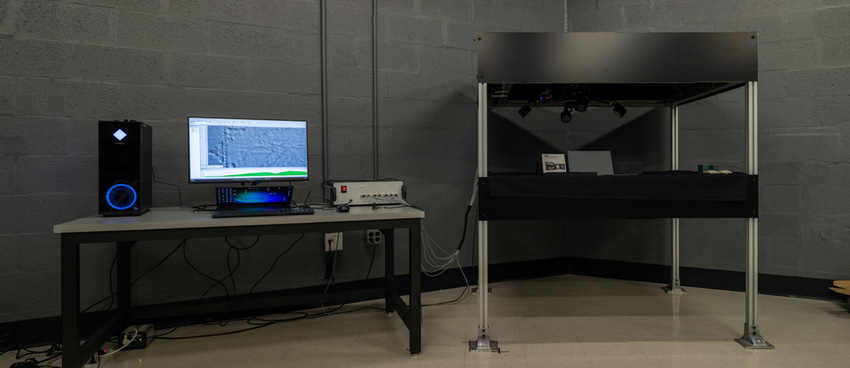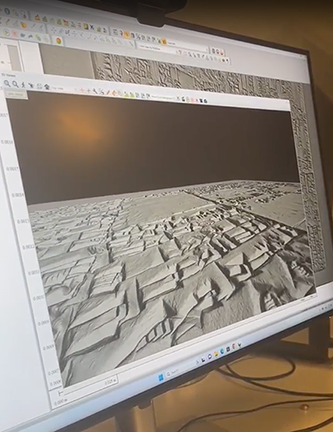Selene Photometric Stereo System with Factum Arte
In August 2023, Jorge Cano and Carlos San Juan completed the installation of a Selene Photometric Stereo System inside the Digital Studio at Princeton University Library. This pioneering recording system developed by Jorge Cano and the Factum Arte engineering team is the first of its kind ever installed in the US and is part of a larger initiative - the Selene Club.


What it does
Selene is able to capture the surface of items like this leather binding at high resolution and record height variations equivalent to less than a fifth the width of a human hair. Both 3D information (the depthmap on the left of the slider) and color (the albedo on the right) are simultaneously and efficiently recorded at the same time. This technology is also used for work done at ARCHiOx.
Composite Images for a Cuneiform Tablet
Selene has captured the topography of the tablet and stylus marks as never before, allowing researchers a more detailed view of what was written and the tool markings, thanks to the generation of a depthmap of the surface and a composite image from the outputs.


PUL has cuneiform tablets?
Yes! PUL's Special Collections has cuneiform holdings containing approximately 1,350 baked and unbaked clay tablets, opened and unopened tablet cases, clay cylinders, nail-shaped cones, pyramid-shaped tags, and other items. Cuneiform writing on clay was in use for approximately three thousand years to record literary texts, school exercises, mathematical computations, and especially documents in Sumerian, Akkadian, and other Mesopotamian languages in what is now Iraq. However, the bulk of the Princeton collection is documentary and archival in nature, chiefly dating from the Third Dynasty of Ur or the Old Babylonian Period (dated 2112–2004 BC and 2004–1595 BC, in accordance with the "Middle Chronology").
Recto
Verso
2.5D Modeling of a Russian Orthodox Quadriptych
The Selene System creates a rendering of the surface of the item being captured, a 2.5D topographic map of low-relief surfaces. The Russian Orthodox Quadriptych (circa 1700-1899) below is a portable folding cast-brass altar in four panels, with ogee-arch crests; highlighted in blue and white enamel. Quadriptychs of this type were manufactured for Old Believer use, 18th-19th centuries. Inscriptions on rectos and outer-panels in Church Slavic. When the quadriptych is fully unfolded, the panels show the following iconographical program, with Old Church Slavic inscriptions:
Panel A: (1) The Annunciation. (2) The Nativity of Christ. (3) Birth of the Virgin. (4) Entrance of the Virgin into the Temple. (Ogee-arch [kokoshnik]): Crucifixion scene (verso). Panel B: (1) The Meeting in the Temple. (2) Baptism of Christ. (3) Transfiguration of Christ (4) Entrance into Jerusalem. (Ogee-arch): Trinity (inscription reads "Ascended into the Heavens and sat at the right side of the Father"). Panel C: (1) Resurrection. (2) Ascension. (3) Holy Trinity. (4) Dormition of the Virgin. (Ogee-arch): Exaltation of the Cross with St. Constantine and St. Helen (inscription reads: "Exaltation of the honorable and life-giving Cross of the Lord"). Panel D: (1) The Tikhvin Virgin with St. Alexander of Jerusalem and St. Cyril (2) The Vladimir Virgin St. Maxim and St. Basil. (3) Virgin of the Sign with St. Anthony and St. Leonty. (4) Smolensk Virgin with St. Anthony and St. Theodosia. (Ogee crest): Praise of the Virgin (inscription reads "Icon of praise of the most Holy Virgin").

![[Russian Orthodox Quadriptych]](https://iiif-cloud.princeton.edu/iiif/2/f5%2Fdf%2F5c%2Ff5df5c7d7fde4a268ff1f90b12579dbd%2Fintermediate_file/full/!800,800/0/default.jpg)
![[Russian Orthodox Quadriptych]](https://iiif-cloud.princeton.edu/iiif/2/7d%2F90%2F30%2F7d90303a594d4531acf54e8ad61d4aa9%2Fintermediate_file/full/!800,800/0/default.jpg)
![[Russian Orthodox Quadriptych]](https://iiif-cloud.princeton.edu/iiif/2/12%2F58%2F68%2F125868744f4447a887d98bf2aca96401%2Fintermediate_file/full/!800,800/0/default.jpg)
![[Russian Orthodox Quadriptych]](https://iiif-cloud.princeton.edu/iiif/2/5b%2Fd4%2Fb9%2F5bd4b92e69bb4a4d9c1c6110086c1773%2Fintermediate_file/full/!800,800/0/default.jpg)
![[Russian Orthodox Quadriptych]](https://iiif-cloud.princeton.edu/iiif/2/99%2F79%2F8e%2F99798edffd5f497eaf1ab40cfb7b5f0f%2Fintermediate_file/full/!800,800/0/default.jpg)
![[Russian Orthodox Quadriptych]](https://iiif-cloud.princeton.edu/iiif/2/f8%2F64%2F71%2Ff8647189309e40de88d69f1b75f30189%2Fintermediate_file/full/!800,800/0/default.jpg)
![[Russian Orthodox Quadriptych]](https://iiif-cloud.princeton.edu/iiif/2/56%2Fd9%2F7a%2F56d97a2d64d34f28a3453af5636e97a0%2Fintermediate_file/full/!800,800/0/default.jpg)